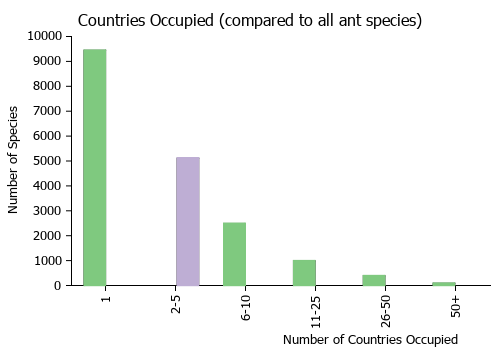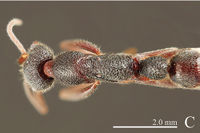Leptogenys kanaoi
| Leptogenys kanaoi | |
|---|---|

| |
| Scientific classification | |
| Kingdom: | Animalia |
| Phylum: | Arthropoda |
| Class: | Insecta |
| Order: | Hymenoptera |
| Family: | Formicidae |
| Subfamily: | Ponerinae |
| Tribe: | Ponerini |
| Genus: | Leptogenys |
| Species group: | modiglianii |
| Species: | L. kanaoi |
| Binomial name | |
| Leptogenys kanaoi Arimoto, 2017 | |
The type colony was collected from rotted wood in a mixed dipterocarp forest. It contained four queens, nine workers and two pupae.
Identification
Arimoto (2017) - A member of the Leptogenys modiglianii species group. In full-face view, head distinctly longer than wide (CI: 78–83). Mandible strongly curved throughout. Clypeus without lateral lobe; apex of median extension strongly projecting. Petiole in profile higher than long (LPI: 112–122), highest just anterior to posterodorsal angle; anterior face of node ventrally vertical and dorsally forming continuous curve with dorsum; dorsal face sloping anteriad. Gastral segment II smooth. smooth.
Keys including this Species
Distribution
Malaysia: Borneo (Sarawak and Sabah).
Latitudinal Distribution Pattern
Latitudinal Range: 4.2° to 4.2°.
| North Temperate |
North Subtropical |
Tropical | South Subtropical |
South Temperate |
- Source: AntMaps
Distribution based on Regional Taxon Lists
Indo-Australian Region: Borneo, Malaysia (type locality).
Distribution based on AntMaps
Distribution based on AntWeb specimens
Check data from AntWeb
Countries Occupied
| Number of countries occupied by this species based on AntWiki Regional Taxon Lists. In general, fewer countries occupied indicates a narrower range, while more countries indicates a more widespread species. |

|
Estimated Abundance
| Relative abundance based on number of AntMaps records per species (this species within the purple bar). Fewer records (to the left) indicates a less abundant/encountered species while more records (to the right) indicates more abundant/encountered species. |

|
Biology
Castes
Nomenclature
The following information is derived from Barry Bolton's Online Catalogue of the Ants of the World.
- kanaoi. Leptogenys kanaoi Arimoto, 2017: 96, figs. 3, 11, 12, 17B, 19B (w.q.) MALAYSIA.
Unless otherwise noted the text for the remainder of this section is reported from the publication that includes the original description.
Description
Worker
(n = 5, holotype in parentheses). HL: 1.66–1.78 (1.77), HLL: 1.18–1.29 (1.24), HLA: 0.16–0.19 (0.19), HW: 1.34–1.43 (1.43), CML: 0.30–0.34 (0.34), CI: 78–83 (81), CLI: 17–19 (19), SL: 1.50–1.63 (1.56), SI: 109–116 (109), EL: 0.34–0.39 (0.36), OI: 27–30 (29), PrL: 1.04–1.09 (1.09), PrH: 0.69–0.74 (0.69), PrW: 1.03–1.07 (1.07), WL: 2.57–2.69 (2.69), PeL: 0.83–0.91 (0.91), PeH: 0.96– 1.06 (1.02), PeW: 0.70–0.75 (0.75), LPI: 112–122 (112), DPI: 78–87 (82).
In full face view, head distinctly longer than wide. Mandible strongly curved throughout, with subapical tooth near apical tooth. Eye prominent, measuring one-fourth to one-third of head lateral margin length. Antennal scape distinctly longer than width of head, surpassing posterior margin of head by one-fifth of its length; antennomere III ca. 2.2 times as long as wide. Clypeus without lateral lobe; median extension moderately long, with apex strongly projecting. In dorsal view, pronotum longer than wide. Metanotal groove distinctly impressed. In profile, propodeal dorsum broadly convex. Petiole in profile higher than long, highest near mid-length, with roughly fan-shaped node; anterior face of node ventrally vertical and dorsally forming continuous curve with dorsum; dorsal face sloping anteriad; posterior face almost straight.
Head weakly areolate-rugose, longitudinally striate anteriorly; vertex weakly and transversally striate. Mandible weakly and longitudinally striate. Prosternum weakly rugose. Gastral segment I with scalloped depressions that are irregular in size and close to each other; segments II smooth.
Body black, gaster slightly tinged with red; clypeus, mandible, antenna, legs and ventral half of petiole dark-red. Apical two or three segments of gaster red-brown. Scalloped depressions on gastral segment I bearing hairs.
Queen
(n = 5). HL: 1.59–1.74, HLL: 1.13–1.26, HLA: 0.16– 0.18, HW: 1.30–1.39, CML: 0.26–0.33, CI: 80–82, CLI: 15–19, SL: 1.39–1.52, SI: 107–110, EL: 0.33–0.40, OI: 29–32, PrL: 0.96–1.03, PrH: 0.65–0.71, PrW: 1.00–1.06, WL: 2.39–2.56, PeL: 0.82–0.86, PeH: 1.03–1.09, PeW: 0.72–0.78, LPI: 123–126, DPI: 88–94. Petiole in profile distinctly higher than long, in dorsal view longer than wide.
Type Material
Holotype. Worker (AK92), from rotted wood, mixed dipterocarp forest, Lambir Hills National Park, Miri, Sarawak, East Malaysia (Borneo), Malaysia, 4.20°N, 114.04°E, 90m, 4 X 2012, Taisuke Kanao leg. FDS. Paratypes (12 workers, 8 queens). 8 workers, 4 queens, same colony as the holotype [4 workers, 2 queens: FDS; 4 workers, 2 queens: Kyushu University Collection; 1 worker, Tower Region, same park, 16 VIII 1995, Seiki Yamane leg. SKY Collection; 3 workers, 4 queens (Eg98-BOR-868), Seipilok Forest, Sabah, East Malaysia (Borneo), Malaysia, 4 VII 1998, Katsuyuki Eguchi leg. [SKYC].
Etymology
Dedicated to Dr. Taisuke Kanao, collector of the material examined.
References
- [[Media:Arimoto, K. 2017. Taxonomy of the Leptogenys modiglianii species group from southeast Asia.pdf|Arimoto, K. 2017. Taxonomy of the Leptogenys modiglianii species group from southeast Asia (Hymenoptera, Formicidae, Ponerinae). ZooKeys 651: 79–106 (doi:10.3897/zookeys.651.*Yamane, S., Tanaka, H.O., Hasimoto, Y., Ohashi, M., Meleng, P., Itioka, T. 2021. A list of ants from Lambir Hills National Park and its vicinity, with their biological information: Part II. Subfamilies Leptanillinae, Proceratiinae, Amblyoponinae, Ponerinae, Dorylinae, Dolichoderinae, Ectatomminae and Formicinae. Contributions from the Biological Laboratory, Kyoto University 31, 87–157.
10366).]]

